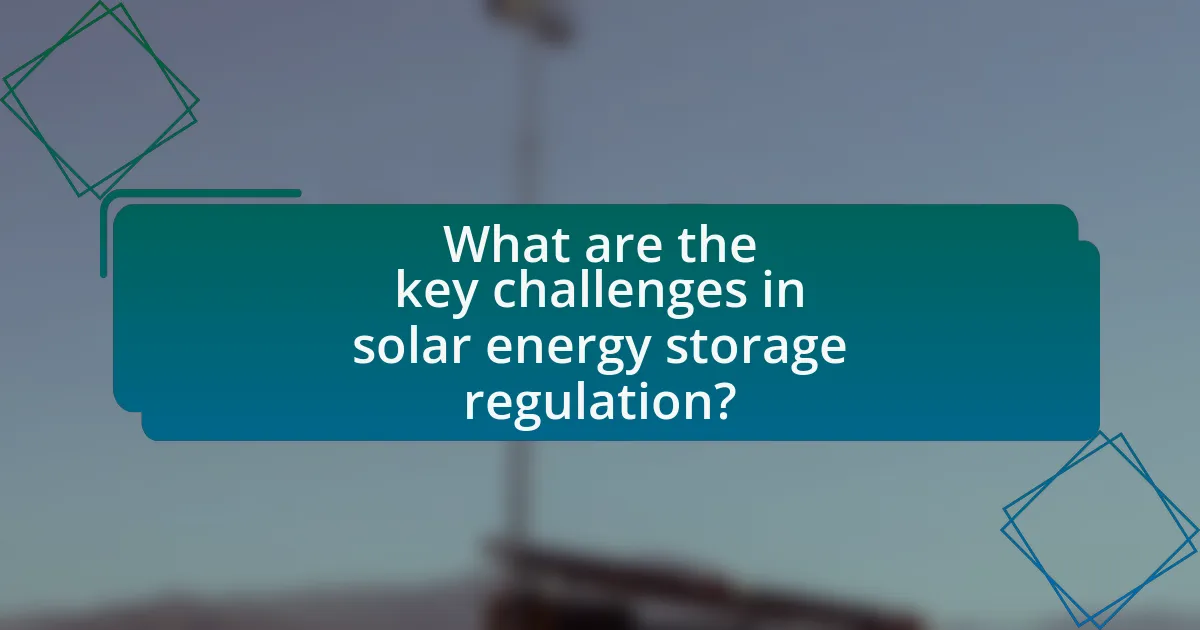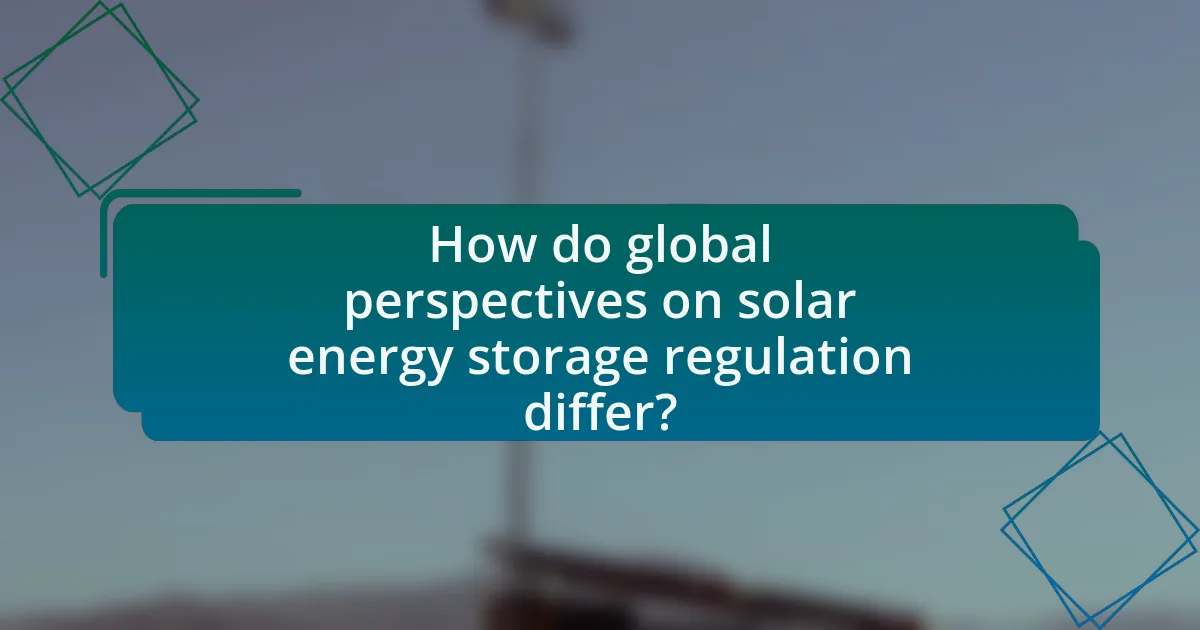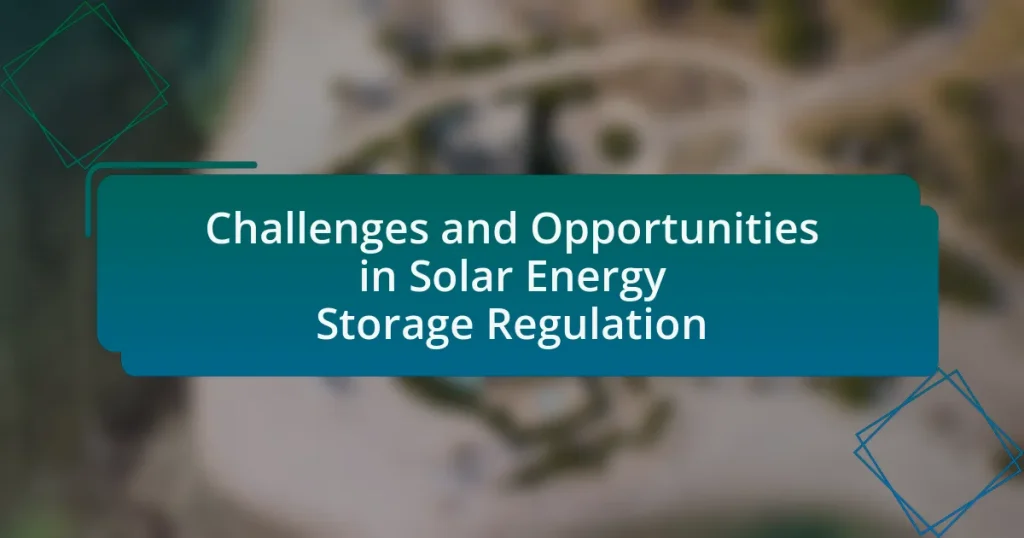The article focuses on the challenges and opportunities in solar energy storage regulation, highlighting key issues such as the lack of standardized policies, complex integration with existing energy systems, and significant infrastructure investment needs. It examines how regulatory frameworks impact the development of solar energy storage, detailing specific regulations that hinder growth, compliance costs, and technological challenges. Additionally, the article discusses the role of safety standards, financial incentives, and streamlined permitting processes in promoting solar energy storage adoption. It also explores global perspectives on regulation, best practices for stakeholders, and future trends influenced by climate change policies and public opinion.
What are the key challenges in solar energy storage regulation?


The key challenges in solar energy storage regulation include the lack of standardized policies, the complexity of integrating storage with existing energy systems, and the need for significant investment in infrastructure. Standardization is crucial as varying regulations across regions create confusion and hinder market growth. The integration challenge arises from the necessity to align storage technologies with grid operations, which requires advanced technical solutions and coordination among multiple stakeholders. Additionally, substantial financial resources are needed to develop and maintain storage systems, which can deter investment and slow down the adoption of solar energy storage solutions.
How do regulatory frameworks impact solar energy storage development?
Regulatory frameworks significantly influence solar energy storage development by establishing the rules and incentives that govern investment and innovation in the sector. These frameworks can either facilitate or hinder the deployment of storage technologies through policies such as tax credits, subsidies, and interconnection standards. For instance, in California, the Self-Generation Incentive Program provides financial incentives for energy storage systems, which has led to a substantial increase in installations, demonstrating how supportive regulations can drive market growth. Conversely, restrictive regulations, such as complex permitting processes or lack of clear guidelines, can create barriers to entry, slowing down the adoption of solar energy storage solutions.
What specific regulations hinder the growth of solar energy storage?
Specific regulations that hinder the growth of solar energy storage include interconnection standards, permitting processes, and utility policies. Interconnection standards can create barriers by imposing lengthy and complex requirements for connecting storage systems to the grid, which delays deployment. Permitting processes often vary significantly by region, leading to inconsistencies that can discourage investment in solar energy storage. Additionally, utility policies, such as lack of incentives for energy storage or unfavorable net metering rules, can limit the financial viability of solar energy storage projects. These regulations collectively create an environment that can stifle innovation and investment in solar energy storage solutions.
How do compliance costs affect solar energy storage projects?
Compliance costs significantly impact solar energy storage projects by increasing the overall financial burden on developers. These costs arise from regulatory requirements, permitting processes, and adherence to safety and environmental standards. For instance, a study by the National Renewable Energy Laboratory indicates that compliance costs can account for up to 30% of the total project expenses, which can deter investment and slow down project deployment. Consequently, higher compliance costs may lead to reduced profitability and limit the scalability of solar energy storage solutions, ultimately affecting the transition to renewable energy sources.
What are the technological challenges faced in solar energy storage?
The technological challenges faced in solar energy storage include limited energy density, high costs, and degradation of storage materials. Energy density refers to the amount of energy stored per unit volume or weight, which is currently low in many battery technologies, making them less efficient for large-scale applications. High costs are associated with advanced battery technologies, such as lithium-ion, which can hinder widespread adoption despite their efficiency. Additionally, degradation of storage materials over time reduces the lifespan and effectiveness of energy storage systems, leading to increased maintenance and replacement costs. These challenges impact the overall efficiency and viability of solar energy as a reliable power source.
How does the efficiency of storage technologies influence regulation?
The efficiency of storage technologies significantly influences regulation by determining the feasibility and economic viability of integrating renewable energy sources into the grid. High-efficiency storage systems can enhance grid stability, reduce energy costs, and support the implementation of policies aimed at increasing renewable energy usage. For instance, the U.S. Department of Energy’s Energy Storage Grand Challenge emphasizes that advancements in storage efficiency can lead to more favorable regulatory frameworks that encourage investment in renewable technologies, as seen in states like California, which has implemented regulations promoting energy storage to meet its ambitious renewable energy targets.
What role do safety standards play in solar energy storage regulation?
Safety standards are crucial in solar energy storage regulation as they ensure the safe design, installation, and operation of energy storage systems. These standards mitigate risks associated with battery failures, fire hazards, and chemical leaks, thereby protecting users and the environment. For instance, the National Fire Protection Association (NFPA) and Underwriters Laboratories (UL) provide guidelines that manufacturers and installers must follow to enhance safety. Compliance with these standards not only promotes public confidence in solar technologies but also facilitates market acceptance and regulatory approval, ultimately supporting the growth of the solar energy sector.
What opportunities exist within solar energy storage regulation?


Opportunities within solar energy storage regulation include the potential for enhanced grid stability, increased investment in renewable technologies, and the facilitation of energy independence. Regulatory frameworks can incentivize the adoption of energy storage systems, which help balance supply and demand, thereby improving grid reliability. For instance, policies that support net metering and energy credits can encourage homeowners and businesses to invest in solar storage solutions, leading to a more resilient energy infrastructure. Additionally, the global market for energy storage is projected to grow significantly, with estimates suggesting it could reach $546 billion by 2035, highlighting the economic potential of regulatory support in this sector.
How can regulatory incentives promote solar energy storage adoption?
Regulatory incentives can significantly promote solar energy storage adoption by providing financial benefits and reducing barriers to entry for consumers and businesses. For instance, tax credits, rebates, and grants can lower the initial investment costs associated with solar energy storage systems, making them more accessible. According to the U.S. Department of Energy, states that have implemented such incentives have seen a marked increase in solar installations; for example, California’s Self-Generation Incentive Program has led to a substantial rise in energy storage capacity. Additionally, regulatory frameworks that allow for net metering and energy storage credits can encourage users to invest in storage solutions, as they can receive compensation for excess energy stored and fed back into the grid. This combination of financial support and favorable policies creates a conducive environment for the widespread adoption of solar energy storage technologies.
What types of financial incentives are most effective?
The most effective types of financial incentives for solar energy storage include tax credits, rebates, and performance-based incentives. Tax credits, such as the Investment Tax Credit (ITC), allow consumers to deduct a percentage of the cost of solar systems from their federal taxes, significantly reducing upfront costs. Rebates provide direct cash back to consumers upon installation, further lowering the financial barrier. Performance-based incentives reward users based on the actual energy produced, encouraging efficient energy use and maximizing system performance. Research indicates that these incentives can lead to increased adoption rates of solar technologies, with studies showing that states offering robust financial incentives see up to 50% higher installation rates compared to those without such programs.
How do streamlined permitting processes benefit solar energy storage?
Streamlined permitting processes benefit solar energy storage by reducing the time and complexity involved in project approvals. This efficiency accelerates the deployment of solar energy storage systems, enabling quicker integration into the energy grid. For instance, a study by the National Renewable Energy Laboratory found that streamlined permitting can cut project timelines by up to 30%, facilitating faster access to renewable energy sources and enhancing grid reliability.
What role does innovation play in shaping solar energy storage regulations?
Innovation plays a crucial role in shaping solar energy storage regulations by driving advancements in technology and efficiency that influence policy frameworks. As new storage technologies, such as lithium-ion batteries and flow batteries, emerge, they necessitate updates to regulations to ensure safety, performance standards, and integration with existing energy systems. For instance, the rapid decrease in battery costs—over 80% since 2010—has prompted regulators to reconsider incentives and subsidies for solar energy storage, aiming to promote wider adoption and grid resilience. Additionally, innovations in smart grid technology and energy management systems require regulatory adaptations to facilitate seamless interaction between solar energy sources and storage solutions, ensuring optimal energy distribution and reliability.
How can emerging technologies influence regulatory frameworks?
Emerging technologies can significantly influence regulatory frameworks by necessitating updates to existing laws and the creation of new regulations that address novel challenges and opportunities. For instance, advancements in solar energy storage technologies, such as lithium-ion batteries and flow batteries, require regulators to consider safety standards, environmental impacts, and grid integration issues. The rapid evolution of these technologies often outpaces current regulations, prompting authorities to adapt frameworks to ensure consumer protection, promote innovation, and facilitate sustainable energy practices. Historical examples include the introduction of regulations for electric vehicles, which evolved as battery technology advanced, demonstrating the need for regulatory bodies to remain agile in response to technological progress.
What are the potential impacts of policy changes on innovation in solar energy storage?
Policy changes can significantly enhance or hinder innovation in solar energy storage. For instance, supportive policies such as tax incentives, grants, and research funding can stimulate investment in new technologies, leading to advancements in efficiency and cost reduction. Conversely, restrictive regulations or lack of clear guidelines can create uncertainty, discouraging companies from investing in innovative solutions. Historical examples include the U.S. Investment Tax Credit, which has driven substantial growth in solar technologies, including storage systems, by providing financial incentives that encourage research and development.
How do global perspectives on solar energy storage regulation differ?


Global perspectives on solar energy storage regulation differ significantly based on regional policies, technological advancements, and market maturity. For instance, countries like Germany and Australia have established comprehensive regulatory frameworks that promote energy storage integration with incentives and subsidies, reflecting their advanced solar markets. In contrast, emerging economies may lack such structured regulations, focusing instead on basic guidelines that do not fully support energy storage development. Additionally, the European Union emphasizes harmonization of regulations across member states to facilitate cross-border energy trading, while the United States exhibits a more fragmented approach, with regulations varying widely by state. These differences highlight the influence of local energy needs, economic conditions, and environmental goals on the regulatory landscape for solar energy storage globally.
What are the leading countries in solar energy storage regulation?
The leading countries in solar energy storage regulation are Germany, the United States, and China. Germany has established comprehensive policies that promote energy storage integration with solar energy, including incentives for battery storage systems. The United States has various state-level regulations and federal initiatives that support solar energy storage, such as the Investment Tax Credit and net metering policies. China is rapidly advancing its regulatory framework to enhance solar energy storage, focusing on large-scale battery projects and supportive government policies. These countries are recognized for their proactive approaches in creating regulatory environments that facilitate the growth of solar energy storage technologies.
How do regulatory approaches vary between developed and developing nations?
Regulatory approaches to solar energy storage differ significantly between developed and developing nations, primarily due to economic resources, technological infrastructure, and policy frameworks. Developed nations often have comprehensive regulatory frameworks that promote innovation and investment in renewable energy technologies, supported by substantial financial resources and advanced technological capabilities. For instance, countries like Germany and the United States implement incentives such as feed-in tariffs and tax credits to encourage solar energy adoption and storage solutions.
In contrast, developing nations frequently face challenges such as limited financial resources, inadequate infrastructure, and less stable political environments, which can hinder the establishment of robust regulatory frameworks. For example, countries like India and Kenya are increasingly adopting regulatory measures to promote solar energy, but these measures often focus on basic access and affordability rather than advanced storage solutions. The International Renewable Energy Agency (IRENA) reports that while developing nations are making strides in renewable energy, they still lag behind in regulatory sophistication compared to their developed counterparts.
What lessons can be learned from international best practices?
International best practices in solar energy storage regulation highlight the importance of standardized policies, stakeholder engagement, and technological innovation. These practices demonstrate that clear regulatory frameworks can facilitate investment and deployment of solar storage solutions, as seen in countries like Germany, which has implemented feed-in tariffs to encourage renewable energy adoption. Additionally, successful models emphasize the need for collaboration among government, industry, and consumers to address challenges such as grid integration and energy equity. For instance, California’s Integrated Resource Planning process showcases how inclusive stakeholder participation can lead to more effective and sustainable energy policies.
What future trends are expected in solar energy storage regulation?
Future trends in solar energy storage regulation are expected to focus on enhanced integration of storage systems with renewable energy sources, increased standardization of technologies, and the implementation of more supportive policies for energy storage deployment. Regulatory frameworks are likely to evolve to facilitate the interoperability of various storage technologies, ensuring they can effectively work with existing grid infrastructures. Additionally, as the demand for energy resilience grows, regulations may increasingly incentivize the adoption of energy storage solutions, particularly in residential and commercial sectors. This shift is supported by the growing recognition of energy storage’s role in stabilizing the grid and enhancing energy security, as evidenced by initiatives in regions like California, which has implemented policies to promote energy storage as part of its broader clean energy goals.
How might climate change policies influence solar energy storage regulations?
Climate change policies can significantly influence solar energy storage regulations by promoting the integration of renewable energy sources and enhancing energy efficiency standards. These policies often include incentives for energy storage technologies, which can lead to more stringent regulations that require improved performance and safety standards for solar energy storage systems. For instance, the implementation of the Clean Power Plan in the United States aimed to reduce carbon emissions, indirectly encouraging the adoption of energy storage solutions to manage intermittent solar power. Additionally, countries like Germany have established regulations that support energy storage deployment as part of their renewable energy transition, demonstrating a clear link between climate policies and regulatory frameworks for solar energy storage.
What role will public opinion play in shaping future regulations?
Public opinion will significantly influence future regulations by driving policymakers to align regulations with the values and preferences of the community. As public awareness of solar energy storage benefits increases, citizens are more likely to advocate for supportive policies, which can lead to the adoption of regulations that promote innovation and investment in this sector. For instance, surveys indicate that a majority of the population supports renewable energy initiatives, which can pressure legislators to prioritize regulations that facilitate solar energy storage development. This dynamic illustrates how public sentiment can serve as a catalyst for regulatory change, ensuring that regulations reflect societal priorities and environmental goals.
What best practices can stakeholders adopt to navigate solar energy storage regulation?
Stakeholders can adopt several best practices to navigate solar energy storage regulation effectively. First, they should stay informed about local, state, and federal regulations, as these can vary significantly and impact project feasibility. Engaging with regulatory bodies and participating in public consultations can provide insights into upcoming changes and influence policy development.
Additionally, stakeholders should collaborate with industry associations to share knowledge and best practices, which can lead to a unified approach in addressing regulatory challenges. Utilizing legal and regulatory experts can also help stakeholders interpret complex regulations and ensure compliance, thereby minimizing risks associated with non-compliance.
Finally, stakeholders should invest in training and education for their teams to understand the regulatory landscape better, which can enhance decision-making and strategic planning. These practices are supported by the increasing complexity of regulations in the solar energy sector, highlighting the need for proactive engagement and informed strategies.


